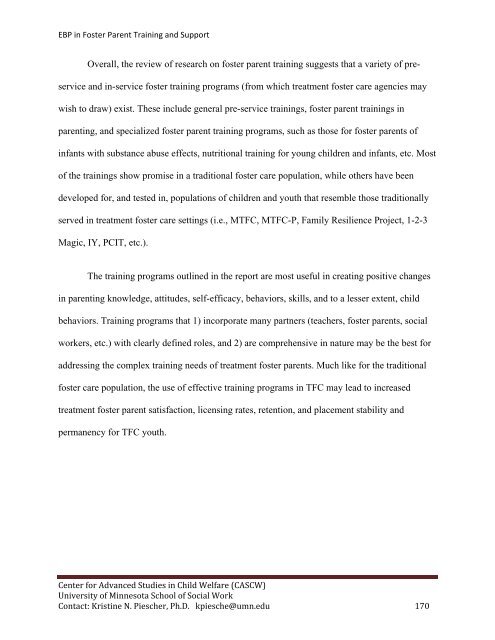Evidence-Based Practice in Foster Parent Training and Support ...
Evidence-Based Practice in Foster Parent Training and Support ...
Evidence-Based Practice in Foster Parent Training and Support ...
You also want an ePaper? Increase the reach of your titles
YUMPU automatically turns print PDFs into web optimized ePapers that Google loves.
EBP <strong>in</strong> <strong>Foster</strong> <strong>Parent</strong> Tra<strong>in</strong><strong>in</strong>g <strong>and</strong> <strong>Support</strong>Overall, the review of research on foster parent tra<strong>in</strong><strong>in</strong>g suggests that a variety of preservice<strong>and</strong> <strong>in</strong>-service foster tra<strong>in</strong><strong>in</strong>g programs (from which treatment foster care agencies maywish to draw) exist. These <strong>in</strong>clude general pre-service tra<strong>in</strong><strong>in</strong>gs, foster parent tra<strong>in</strong><strong>in</strong>gs <strong>in</strong>parent<strong>in</strong>g, <strong>and</strong> specialized foster parent tra<strong>in</strong><strong>in</strong>g programs, such as those for foster parents of<strong>in</strong>fants with substance abuse effects, nutritional tra<strong>in</strong><strong>in</strong>g for young children <strong>and</strong> <strong>in</strong>fants, etc. Mostof the tra<strong>in</strong><strong>in</strong>gs show promise <strong>in</strong> a traditional foster care population, while others have beendeveloped for, <strong>and</strong> tested <strong>in</strong>, populations of children <strong>and</strong> youth that resemble those traditionallyserved <strong>in</strong> treatment foster care sett<strong>in</strong>gs (i.e., MTFC, MTFC-P, Family Resilience Project, 1-2-3Magic, IY, PCIT, etc.).The tra<strong>in</strong><strong>in</strong>g programs outl<strong>in</strong>ed <strong>in</strong> the report are most useful <strong>in</strong> creat<strong>in</strong>g positive changes<strong>in</strong> parent<strong>in</strong>g knowledge, attitudes, self-efficacy, behaviors, skills, <strong>and</strong> to a lesser extent, childbehaviors. Tra<strong>in</strong><strong>in</strong>g programs that 1) <strong>in</strong>corporate many partners (teachers, foster parents, socialworkers, etc.) with clearly def<strong>in</strong>ed roles, <strong>and</strong> 2) are comprehensive <strong>in</strong> nature may be the best foraddress<strong>in</strong>g the complex tra<strong>in</strong><strong>in</strong>g needs of treatment foster parents. Much like for the traditionalfoster care population, the use of effective tra<strong>in</strong><strong>in</strong>g programs <strong>in</strong> TFC may lead to <strong>in</strong>creasedtreatment foster parent satisfaction, licens<strong>in</strong>g rates, retention, <strong>and</strong> placement stability <strong>and</strong>permanency for TFC youth.Center for Advanced Studies <strong>in</strong> Child Welfare (CASCW)University of M<strong>in</strong>nesota School of Social WorkContact: Krist<strong>in</strong>e N. Piescher, Ph.D. kpiesche@umn.edu 170
















